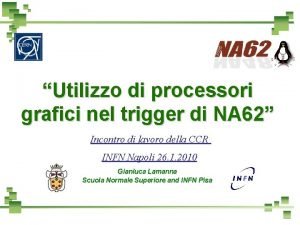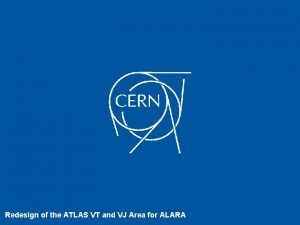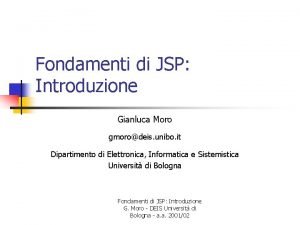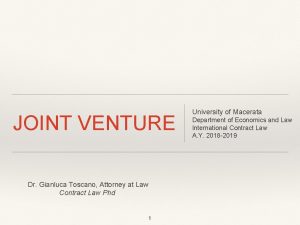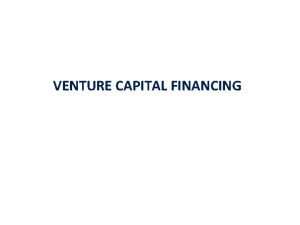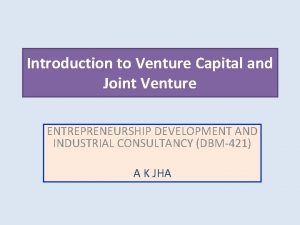JOINT VENTURE Dr Gianluca Toscano Attorney at Law
























- Slides: 24

JOINT VENTURE Dr. Gianluca Toscano, Attorney at Law Contract Law Phd 1 University of Macerata Department of Economics and Law International Contract Law A. Y. 2019 -2020

1. INTRODUCTION J. V. in Contract Law 2

1. 1. B 2 B RELATIONSHIPS ❖ ❖ ❖ Enterprises (and professionals as well) need to build relations with other entities in order to achieve their objectives, like making profits, increasing market share, enhance their competitiveness. Essentially, these are the reasons why individuals and companies enter into contracts. Every contractual connection requires some sort of cooperation between the parties. However, we can clearly identify different types of agreements on the basis of how strong and deep their bonds are. Different degrees of integration are related to different purposes of the parties that enter into the contract 3

1. 2. TYPES OF COMMERCIAL CONTRACTS ❖ ❖ Exchange contracts (sale of goods, provision of services): one party promises to pay money (or another valuable asset) in exchange of goods or services provided by another party ————> CONFLICT OF INTERESTS, MINIMUM INTEGRATION Distribution contracts (agency, franchising, distribution and dealer agreements): parties execute a main agreement to establish terms and conditions of frequent deals, thus creating a stable long-term relationship————> COMMON INTERESTS, COOPERATING CONDUCT, INDEPENDENT ENTITIES Time-limited partnership contracts: (Unincorporated J. V. ): parties make a commitment to cooperate for a specific project or in a predetermined period, in a condition of equality, yet not establishing a new entity—————> COMMON INTERESTS, CONTRACTUAL BONDS, SAME RIGHTS AND DUTIES Incorporation contracts: (Corporation agreement, Incorporated J. V. ): two or more individuals and/or companies set up a new corporation with its own legal rights and liability, whose capital is owned by shareholders ———————> COMMON INTERESTS, NEW ENTITY, MEMBERS SHARE RIGHTS AND DUTIES 4

1. 3. KINDS OF JOINT VENTURES ❖ ❖ UNINCORPORATED JOINT VENTURE (i. e. Contractual J. V. ) INCORPORATED JOINT VENTURE (i. e. Equity J. V. ) 5

1. 4. COMMON TRAITS OF J. V. AGREEMENTS ❖ ❖ In both contracts, the parties are aiming at setting up a partnership and are willing to cooperate in pursuing common interests The parties take particular care in ensuring that the business they are going to carry out together will be managed and governed in condition of equality among them. 6

1. 5. INTERNATIONAL JOINT VENTURE ❖ ❖ Both Unincorporated and Incorporated J. V. are deemed to be International contracts when law systems of two or more countries are potentially applicable to the execution, interpretation or performance of the contract. Examples of international J. V. : • parties are located in different countries • parties are located in the same country, but obligations arising out of the contract must be performed in another one • In case of Incorporated J. V. , the brand new corporation is set in a different country from the one where one party is located 7

2. UNINCORPORATED JOINT VENTURE 8

2. 1. UNINCORPORATED Joint Venture Sample cases ❖ ❖ Two or more companies put together their resources and expertise to perform a relevant project or work they would not be able to do on their own. For instance, a procurement to build a big public infrastructure (roads, buildings etc. ) Two or more entities jointly bid at a public auction in order to win the contract. 9

2. 2. UNINCORPORATED Joint Venture Distinctive features ❖ ❖ Parties to the contract (named co-venturers) remain independent. They do not set up any new legal entity Duration of the agreement is predetermined in relation to one or more specific project/work/affair or for a given period of time The co-venturers are deemed jointly and severally liable for the performance of duties and obligations towards third parties Rights and duties are shared between the parties in a way that ensure equality among them 10

2. 3. UNINCORPORATED Joint Venture Elements of the contract ❖ ❖ Intention to be bound Consideration: put together material or immaterial assets to accomplish a major economic or financial goal. Parties may agree to cooperate in performing every obligation arising out of the contract (Integrated J. V. ) or to carry out a specific task, often at different stages of the production chain (Consortium) Form: even if it is not mandatory, written form is highly recommended, given the wide range of clauses which the parties need to insert Content: rules on evaluating each party’s contribution and on managing the performance of the work in condition of equality 11

2. 4. MODEL UNINCORPORATED J. V. AGREEMENT ❖ SOURCE: International Trade Centre, a multilateral agency of the United Nations based in Geneva. It’s in charge of promoting and developing international business exchanges. It provides technical assistance in trades and drafts a range of commercial contractual models to support enterprises willing to play in the international market scenario 12

2. 4. 1. Model Unincorporated J. V. agreement Main provisions 1 ❖ ❖ Recitals: Purposes of the parties regarded as individuals Contractual definitions: expressions used in contract agreed meanings of Object: results that the parties are willing to achieve carrying out what is agreed in the contract Contributions and commitments of the parties: what each party should do and share to accomplish the tasks they set out 13

2. 4. 2. Model Unincorporated J. V. agreement Main provisions 2 ❖ ❖ Powers of representation: how the parties are entitled to represent the J. V. towards third parties. Due to the absence of a new legal entity, every commitment made by one party is binding for the J. V. , unless the agreement provides limitations that third parties knew (or should have known) before the commitment was made Managing decisions: who has the power to take decisions. Usually both parties are entitled to do so, as they have equal duties and rights 14

2. 4. 3. Model Unincorporated J. V. agreement Main provisions 3 ❖ ❖ ❖ Share in profits and losses: rules about distribution of revenues and losses among the parties. Sharing is usually in equal portions or at least in proportion to the contribution each one provided Liability: due to the lack of a new corporation with its own legal rights, the parties are jointly and severally liable towards third parties for every obligation of the J. V. However, each party bears an equal share of liability in internal relations Termination: the J. v. ceases to be effective if a particular event occurs: ❖ ❖ EXPIRATION (passing of time or accomplishment of the objectives) FRUSTRATION (obligations cannot be performed or targets are not achieved E. g. DEADLOCKS) ❖ MUTUAL DECISION (the parties jointly decide to terminate the contract) ❖ UNILATERAL DECISION (if permitted) ❖ BREACH OF THE CONTRACT (the injured party could claim for compensation and has the right to terminate the contract) 15

2. 4. 4. Model Unincorporated J. V. agreement Main provisions 4 ❖ ❖ Competition: the parties are committed to jointly pursue their objectives, and promise not to compete with each other Boilerplate clauses: HARDSHIP, BEST EFFORTS, GOOD FAITH, ENTIRE CONTRACT, FORCE MAJEURE Applicable law: choice of governing law Resolution of disputes: commitment to amicable settlement of deadlocks, a. d. r. and arbitrates 16

3. INCORPORATED JOINT VENTURE 17

3. 1. INCORPORATED Joint Venture Sample cases ❖ ❖ When a company is willing to penetrate in a foreign market, usually it needs to settle in that market for technical or economical reasons, being often (and somewhere always) compelled to set up a new entity subject to domestic law. In doing so, it enters into a J. V. agreement with a local entity, in order to take advantage of its expertise and knowledge of domestic rules. On the other hand, the domestic company enjoys increased competitiveness and additional cash flow from abroad. When two or more parties want to pool together their own knowhows, material or financial resources aiming at reducing production costs or optimizing their supply chain 18

3. 2. INCORPORATED Joint Venture Distinctive features ❖ ❖ This type of J. V. describes a complex set of agreements, including an incorporation agreement. The parties always set up a new company The new company thus established (Joint Subsidiary) has its own legal rights and obligations and a limited liability towards third parties. The co-venturers don’t bear any liability. The parties create a long-term relationship, since the contract has an undefined duration The parties establish many rules to make sure that equal powers and rights are preserved in managing the new company (even if these provisions conflict with the corporation law applicable to the newly founded entity) 19

3. 3. INCORPORATED Joint Venture Elements of the contract ❖ ❖ Intention to be bound Consideration: setting up a new corporation and establishing rules aiming at keeping balance and equality among the subscribers Form: Mandatory written form for the incorporation agreement. Highly recommended for all the connected agreements Content: Various linked agreements, each of them suitable to regulate different stages of the cooperation 20

3. 4. INCORPORATED Joint Venture Types of connected arrangements ❖ ❖ ❖ 1) Pre-incorporation (or Subscription) Agreement: provides terms and conditions for the incorporation of the joint subsidiary and for the upcoming actions (Ex: closing date, shareholders’ contribution, restriction of competition etc. ) 2) Memorandum and articles of association clauses: modifying or adding conditions to these formal acts to ensure equality among members. They are unusual, since they may result in formal violation of the applicable law, which is always the one of the country where the incorporation is made (E. g. modification of voting power in the management board or in the shareholders meeting in breach of the proportional rule) 3) Shareholders’ agreement: it provides the rules on voting rights and duties, on the appointment of the management board members, on decision power and the quorum required to adopt certain decision, and limitation on shares’ selling. These clauses could make exceptions to governing corporation law and/or be subject to a different governing law and still be binding among the parties 21

3. 4. bis INCORPORATED Joint Venture Types of connected arrangements ❖ ❖ 4) Business agreement: it contains the provisions about carrying out the business and affairs, about the task that each party is entrusted to carry out, about any predictable interaction between the parties during the subsidiary activity 5) Ancillary agreements: deals signed among the coventurers and the joint subsidiary to establish rights and obligations in enjoying material and immaterial resources provided to the company (know/how, copyright trademark etc) 22

3. 5. INCORPORATED Joint Venture Particular clauses (Itc model agreement and American Bar Ass. ) ❖ Rules on company governance: ❖ ❖ restriction of m. board power through reserving significant decisions to the co-venturers appointment of the board members and accountability to the co -venturers ❖ Rules on destination of profits ❖ Restriction or prohibition of share transfer ❖ Put and call options established to regulate exit from J. V. ❖ Termination, dissolution and liquidation of the Joint Venture 23

4. Antitrust Art. 101 TFEU (Treaty on functioning of the European Union) The following shall be prohibited as incompatible with the internal market: all agreements between undertakings, decisions by associations of undertakings and concerted practices which may affect trade between Member States and which have as their object or effect the prevention, restriction or distortion of competition within the internal market, and in particular those which: (a) directly or indirectly fix purchase or selling prices or any other trading conditions; (b) limit or control production, markets, technical development, or investment; (c) share markets or sources of supply………OMISSIS 2. Any agreements or decisions prohibited pursuant to this Article shall be automatically void. 3. The provisions of paragraph 1 may, however, be declared inapplicable in the case of: —any agreement or category of agreements between undertakings, —any decision or category of decisions by associations of undertakings, —any concerted practice or category of concerted practices, which contributes to improving the production or distribution of goods or to promoting technical or economic progress, while allowing consumers a fair share of the resulting benefit, and which does not: (a) impose on the undertakings concerned restrictions which are not indispensable to the attainment of these objectives; (b) afford such undertakings the possibility of eliminating competition in respect of a substantial part of the products in question. 24
 Joint venture account
Joint venture account Taci
Taci Peppe nappa siciliano stenterello che è toscano
Peppe nappa siciliano stenterello che è toscano Istituto toscano tumori
Istituto toscano tumori Francesco toscano moglie
Francesco toscano moglie Francesco toscano biografia
Francesco toscano biografia Romanico toscano
Romanico toscano Francesco toscano
Francesco toscano Joint venture merger and acquisition
Joint venture merger and acquisition Materi akuntansi keuangan lanjutan 1 joint venture
Materi akuntansi keuangan lanjutan 1 joint venture Unpopulated joint venture accounting
Unpopulated joint venture accounting Atlantic coast joint venture
Atlantic coast joint venture Que es un joint venture
Que es un joint venture Joint venture
Joint venture Justin dibb allied gold
Justin dibb allied gold Gianluca stringhini
Gianluca stringhini Gianluca attura
Gianluca attura Gianluca lamanna
Gianluca lamanna Gianluca verona rinati
Gianluca verona rinati Gianluca camplone
Gianluca camplone Gianluca cavoto
Gianluca cavoto Francesco moro unibo
Francesco moro unibo Nprinting 17
Nprinting 17 Gianluca iannaccone
Gianluca iannaccone Filippo corridoni
Filippo corridoni

















